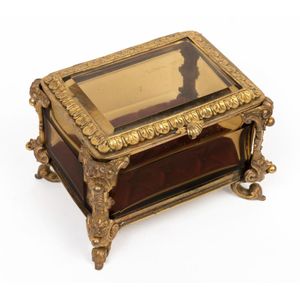Gilt Bronze Jewel Box with Stone Set Pencil
A French gilt bronze mounted glass jewel box, late 19th century, together with a rolled gold stone set propelling pencil, the box 11 cm high, 15 cm wide, 12 cm deep
You must be a subscriber, and be logged in to view price and dealer details.
Subscribe Now to view actual auction price for this item
When you subscribe, you have the option of setting the currency in which to display prices to $Au, $US, $NZ or Stg.
This item has been sold, and the description, image and price are for reference purposes only.
- Rolled Gold - A type of gold plating devloped in the early 19th century, similar to Sheffield plating of silver, where the the gold is fused under pressure and heat to a base metal, usually brass, and then rolled into sheets of the required thickness.
The thickness of the gold plate can vary. In Britain the thickness of the gold is measured in microns. A micron is one-thousandth of a millimetre and 20 microns of gold is considered good quality. In the USA a differnt method is used that takes account of the total weight of the object.
Also, the purity of the gold, measured in carats can vary, with 24 carat being the purest. The gold in most rolled gold objects will be between 9 and 14 carats.
There are other chemical and electroplating methods of applying gold plate to a base metal, but rolled gold is considered a superior plate to a "gold plated" object.
Depending on the country and date of manufacture, the object may be stamped "Rolled Gold" or similar, but if there is any doubt as to whether an object is solid gold, or some type of gold plating, it is preferable to have it tested by a jeweller. - Bronze - An alloy of copper and tin, traditionally in the proportions of about 9 parts of copper to 1 part of tin.
The discovery of bronze in Western Asia in the 4th century enabled people to create metal objects which were superior to those previoulsy possible because of its strength and hardness, and it has been used throughout the world for weapons, coins, tools, statuary and other decorative items.
It is very fluid in a molten state, and its hardness, strength when set, and non-corrosive properties makes it most suitable for casting sculpture.
This item has been included into following indexes:
- boxes, material or decoration
